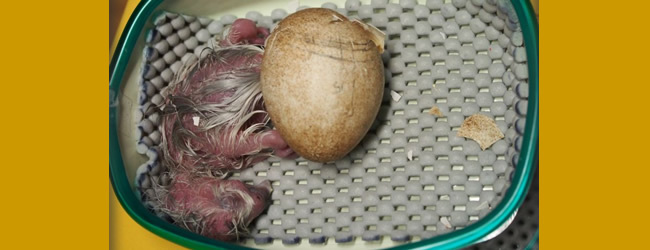
 Optimistic prognosis of New Zealand conservationists about successful breeding season of Kakapo parrots are coming true. At the beginning of this year, representatives of Kakapo Recovery Team predicted that 30-40 chicks might hatch. It seems that reality is even better because at this moment they record over 100 eggs. Such large number of Kakapo parrots have never nest before and therefore conservationists are busy with monitoring the first laid eggs and hatched chicks.
Optimistic prognosis of New Zealand conservationists about successful breeding season of Kakapo parrots are coming true. At the beginning of this year, representatives of Kakapo Recovery Team predicted that 30-40 chicks might hatch. It seems that reality is even better because at this moment they record over 100 eggs. Such large number of Kakapo parrots have never nest before and therefore conservationists are busy with monitoring the first laid eggs and hatched chicks.
“Apologies for the lack of posts – we’ve been busy!” said Kakapo Recovery Team on its facebook page.
“Kākāpō breeding season is in full swing: 43 females mated, 43 nests, 106 eggs across 3 islands, with around 50% fertility. It’s a busy one! More details coming soon”, they promised.
a
a
In this year, it was the first time since 2009 when conservationists used artificial insemination for higher egg fertility. Another reason was also to create new gene combinations and so improve genetic polymorphism of the whole population.
“We’ve put a lot of effort into artificial insemination on Whenua Hou this year, using it to improve fertility, ensure good genetic matches, and to try to produce offspring from males who have never successfully bred. In 2009 the programme produced 3 AI chicks (a first for any wild bird species), but none since,” said representatives of Kakapo Recovery team.
a
Artificial insemination is a demanding procedure. Sperm has to be collected at the exact time and implemented it to the female’s reproductive tract after she lays the first egg. On February 19th, the first chick hatched on the Anchor Island. Its mother is seven years old Tiwhiri. This was also her first nesting.
a
a
Conservationists are also very happy about hatching of two chicks at Kuia’s nest.
“YES, YES, YESSS!! We’ve waited 18 years for this moment! Kuia’s first chick has hatched, making it just the fourth living kakapo to have unique Fiordland genes!” they announced on official fb page. Those genes are very important for the whole population as up to now only birds coming from Stewart Island have been reproducing. From the original isolated population of Kakapos living on Fiorland only three birds are surviving – Kuia, Sindibád and Gulliver. They are all brothers and sisters.
a
The second chick at Kuia’s nest was hatched on February 22nd “Kuia’s second egg has hatched AND she has mated again so a another clutch is possible!” informed Kakapo Recovery Team.
However, there is also bad news to inform about. On February 19th, conservationists found a corpse of an adult Kakapo male which probably died when fighting with another male.
a

Mating diagram of Kakapos on Anchor Island
a
“He was first discovered on Stewart Island 25 years ago, so his age is unknown. He fathered two chicks in 2009 and had mated with Pura, 10 days before his death. His body has been sent to Auckland Zoo where vets will investigate the cause,” said representatives of Kakapo Recovery Team.
At that time, the Kakapo population counted 126 individuals. Now with the new hatched chicks it is 129. The age of 31 old Kakapos which come from Steward Island is unknown. All these birds were discovered in 80’s. “Potentially, quite a few of these kākāpō could be quite old – 60 years-plus even, so deaths within that group are to be expected,” said biologists. Contrary to the case of dead male, these birds would die naturally. This species has a lifespan of 90+ years. The recovery team also informed about a female which nested in this year for the first time after 35 years. Her last chicks were hatched in 1981, biologists are waiting if the clutch is fertile.
a
Title photo: Kuia’s chick. (c) fb page Kakapo Recovery Team
Pingback: Kakapo season 2015-16 » New Zealand - Page 2